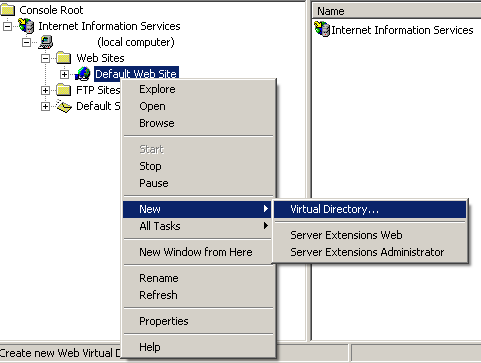What is Virtual Directory
A virtual directory is a user-defined directory name that is configured in Internet Information Services (IIS) and linked to a physical directory on the local server's storage or a directory on a remote server. By utilizing the Internet Information Services Manager, administrators can easily create virtual directories for ASP.NET Web applications hosted in IIS.
The virtual directory name becomes an integral part of the application's URL, serving as a user-friendly alias or nickname. This alias is often shorter and more convenient for users to type compared to the actual path of the physical directory. When a query or request is made, the virtual directory efficiently routes it to the appropriate backend identity repositories. It seamlessly combines identity data from diverse and heterogeneous data stores, presenting a unified and cohesive view as if it originated from a single source.
How to create a virtual directory by using IIS Manager

- In IIS Manager, expand the local computer and the Web site to which you want to add a virtual directory.
- Right-click the site or folder in which you want to create the virtual directory, click New, and then click Virtual Directory.
- In the Add Virtual Directory dialog box, at a minimum enter information in the Alias and Physical path and then click OK.
Conclusion
By default, Internet Information Server uses configuration from Web.config files in the physical directory to which the virtual directory is mapped, as well as in any child directories in that physical directory
- Asp.Net Interview Questions (Part-1)
- Asp.Net Interview Questions (Part-2)
- Advantages of ASP.NET Web Development
- What is IIS - Internet Information Server
- What is HttpHandler
- Page Directives in Asp.Net
- What is a postback
- What is IsPostBack
- What is global.asax
- Difference between Machine.config and web.config
- Difference between HTML control and Web Server control
- What is Query String
- Difference between Authentication and Authorization
- How to secure Connection Strings
- What is ASP.Net tracing
- Passing values between Asp.Net pages
- Differentiate between client side validation and server side validation
- How to Get host domain from URL
- Adding a Favicon To Your Website
- Asp.Net Textbox value in Javascript
- AutoEventWireup attribute in ASP.NET
- Can I use multiple programming languages in a ASP.net Web Application?
- Difference: Response.Write and Response.Output.Write
- How many web.config files can I have in an application?
- What is Protected Configuration in asp.net?
- Static variablesin .Net , what is their life span?
- Difference between ASP Session and ASP.NET Session?
- What does mean Stateless in Asp.Net?
- What is the Difference between session and caching?
- What are different types of caching using cache object of ASP.NET?
- Which method is used to remove the cache object?
- How many types of Cookies are available in ASP.NET?
- What is Page Life Cycle in ASP.net?
- What is the code behind and Inline Code in Asp.Net?
- What is master page in ASP.NET?
- Can you change a Master Page dynamically at runtime?
- What is cross-page posting in ASP.NET?
- How to redirect a page in asp.net without performing a round trip ?
- How to register custom server control on ASP.NET page?
- How do you validate Input data in Asp.Net?
- What's the difference between ViewData and ViewBag?
- Difference between Response.Redirect and Server.Transfer
- What is the function of the CustomValidator control?
- Define RequiredFieldValidator?
- Difference between custom control and user control
- Difference between Label and Literal control in ASP.Net
- What are the major events in Global.Asax file?
- What is Event Bubbling in asp.net ?
- What is Delay signing?
- What is the difference between in-proc and out-of-proc?
- What is the difference between POST and GET?
- A potentially dangerous Request.Form value was detected from the client